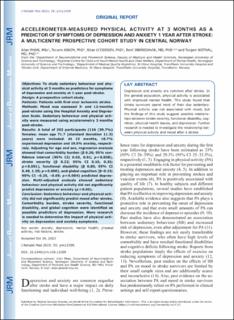| dc.contributor.author | Phan, Ailan | |
| dc.contributor.author | Askim, Torunn | |
| dc.contributor.author | Lydersen, Stian | |
| dc.contributor.author | Indredavik, Bent | |
| dc.contributor.author | Wethal, Torgeir | |
| dc.date.accessioned | 2024-01-22T11:48:36Z | |
| dc.date.available | 2024-01-22T11:48:36Z | |
| dc.date.created | 2023-11-16T11:04:26Z | |
| dc.date.issued | 2023 | |
| dc.identifier.issn | 1650-1977 | |
| dc.identifier.uri | https://hdl.handle.net/11250/3113076 | |
| dc.description.abstract | Objectives: To study sedentary behaviour and physical activity at 3 months as predictors for symptoms of depression and anxiety at 1-year post-stroke.
Design: A prospective cohort study.
Patients: Patients with first-ever ischaemic stroke.
Methods: Mood was assessed 3- and 12-months post-stroke using the Hospital Anxiety and Depression Scale. Sedentary behaviour and physical activity were measured using accelerometry 3 months post-stroke.
Results: A total of 292 participants (116 (39.7%) females; mean age 71.7 (standard deviation 11.3) years) were included. At 12 months, 16.7% experienced depression and 19.5% anxiety, respectively. Adjusting for age and sex, regression analysis showed that comorbidity burden (β 0.26; 95% confidence interval (95% CI) 0.02, 0.51; p = 0.038), stroke severity (β 0.22; 95% CI 0.10, 0.35; p = 0.001), functional disability (β 0.89, 95% CI 0.49, 1.30; p = 0.000), and global cognition (β–0.15; 95% CI –0.25, –0.05; p = 0.004) predicted depression. Multi-adjusted analysis showed sedentary behaviour and physical activity did not significantly predict depression or anxiety (p > 0.05).
Conclusion: Sedentary behaviour and physical activity did not significantly predict mood after stroke. Comorbidity burden, stroke severity, functional disability, and global cognition were identified as possible predictors of depression. More research is needed to determine the impact of physical activity on depression and anxiety symptoms. | en_US |
| dc.language.iso | eng | en_US |
| dc.publisher | Medical Journals Sweden AB | en_US |
| dc.rights | Navngivelse-Ikkekommersiell 4.0 Internasjonal | * |
| dc.rights.uri | http://creativecommons.org/licenses/by-nc/4.0/deed.no | * |
| dc.title | Accelerometer-measured physical activity at 3 months as a predictor of symptoms of depression and anxiety 1 year after stroke: a multicentre prospective cohort study in central Norway | en_US |
| dc.title.alternative | Accelerometer-measured physical activity at 3 months as a predictor of symptoms of depression and anxiety 1 year after stroke: a multicentre prospective cohort study in central Norway | en_US |
| dc.type | Peer reviewed | en_US |
| dc.type | Journal article | en_US |
| dc.description.version | publishedVersion | en_US |
| dc.source.volume | 55 | en_US |
| dc.source.journal | Journal of Rehabilitation Medicine | en_US |
| dc.identifier.doi | 10.2340/jrm.v55.12309 | |
| dc.identifier.cristin | 2197507 | |
| cristin.ispublished | true | |
| cristin.fulltext | original | |
| cristin.qualitycode | 1 | |

